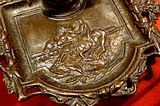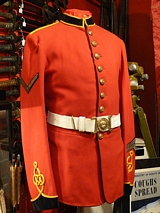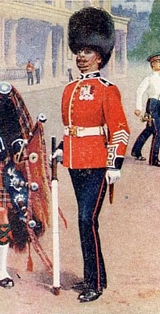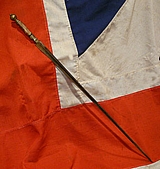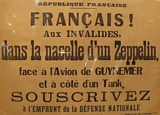A Most Rare Large Aviation Medal For the Acceptance Run of the 'LZ 4'.Zeppelin
Medal 1908, by A. Galambos. On the acceptance run of the 'LZ 4'. Germania with sword in the right wreath medallion of Count Zeppelin under oak, right a crowd of faces in an auditorium and an airship above / winged male figure with torn chain over globe and cloud. Kaiser 292.3, Gutt 14
Obverse — Goddess Germania with Sword in right hand. 60 mm. They made a smaller 33 mm silver version, and a small undated bronze version 33mm but this is the very rare, large gilt bronze version, of 60mm
Dir/ Danken/ Deine/ Deutschen.
A. Galambos on bottom
inscription — 4. 5. August 1908 on the left. A. Galambos. The Zeppelin LZ 4 was a German experimental airship constructed under the direction of Ferdinand von Zeppelin. First flown on 20 June 1908, it made a series of successful flights including a 12-hour flight over Switzerland. It was destroyed when it caught fire after landing to carry out engine repairs during a projected 24-hour endurance trial.This disaster proved fortunate for Zeppelin: donations by the German public raised 6.5 million marks, so guaranteeing the future of his development of airships. . At Westfälische Auktionsgesellschaft
Auction 71, 29-30 April 2014, a much smaller silver more common version of this medal sold for 480 euro. read more
450.00 GBP
A Super, Antique Bronze Equestrian ' Horse Racing' Collectable
Ideal for the gentleman or lady with a passion for horse racing, horses or equine collectibles. In fine cast bronze, in the form of chamber stick. With a finely detailed relief design of a horse race, showing two race horses side by side with jockeys. With a mount for a matchbox, and a rear finger loop for holding and carrying. read more
275.00 GBP
All Now Sold +++Individual Illuminated Psalter Leaves, 12th to 13th Century
19 remaining Vellum leaves from a Psalter from the reign of King Philip Augustus (1179-1223), with burnished gold initials, from Northern France. Each leaf will be around £2,400 gbp. Twenty plus lines of the finest Gothic angular script on the recto and verso, decorated with initials adorned in gold leaf and pen work ornamentation
in red and blue tempera. Margins filled with floral scrolls, characters and stylized heads or grotesque. This was a way for the scribes of this period to add little individual touches to their work.
A part of the Psalm 73 to Psalm 76, then 79 to 84. Psalm 73 of the Book of Psalms is one of the "Psalms of Asaph"; it has been categorized as one of the Wisdom Psalms".
Probably produced in North-Eastern France, perhaps in the region around Soissons, Noyons, and Lyon, or at least certainly influenced by court productions of this area and manuscripts produced in Ile-de-France, especially those of Abbey St. Victor.
Although the original patron cannot be identified, the lavish use of gold leaf and high quality lead us to suspect that the work was possibly produced for a member of the court.
24 cm height x 16.75 cm width Sample example but generic photos. Email for further enquiries, we had 19 psalter pages remaining from the collection of 29 but all now sold. read more
Price
on
Request
A Very Good Pre WW1 Royal Engineer's Dress Uniform for Lance Corporal
Tunic and trousers. In excellent condition for age. Fine red cloth with single bullion corporal stripe . Fine original Royal Engineer buttons. Austrian knots and cuffs. British other ranks and NCO's uniforms made prior to WW1 are very sought after and so few survive today as to make them most scarce and very interesting. Makers label inside with date. read more
495.00 GBP
A Most Scarce WW1 Scot's Guardsman's Tunic, Part of The British Monarch’s Personal Guard
Tunic in traditional red with brass buttons. The centre regiment of the five Guards Regiments of the Household Div. The Scots Guards have over three hundred and sixty years of unbroken service to the crown. They can trace their origins back to an army that was raised by Archibald 1st Marquess of Argyll, 16 March 1642. Since this date the Regiment has served in nearly every campaign in which the British Army has been involved in. In 1686 they were brought onto the establishment of the English Army for the first time. Eight years later they took precedence within the Foot Guards, despite their seniority by length of service. The Battle Honours of the Regiment are;
Namur 1695, Dettingen, Lincelles, [Egypt]1, Talavera, Barrosa, Fuentes d?Onor, Salamanca, Nive, Peninsula, Waterloo, Alma, Inkerman, Sevastopol, Tel-el-Kebir, Egypt 1882, Suakin 1885, Modder River, South Africa 1899-1902
First World War: Retreat from Mons, Marne 1914, Aisne 1914, Ypres 1914 ?17, Langemarck 1914, Gheluvelt, Nonne Bosschen, Givenchy 1914, Neuve Chapelle, Aubers, Festubert 1915, Loos, Somme 1916 ?18, Flers-Courcelette, Morval, Pilckem, Poelcappelle, Passchendaele, Cambrai 1917 ?18, St. Quentin, Albert 1918, Bapaume 1918, Arras 1918, Drocourt-Qu?ant, Hindenburg Line, Havrincourt, Canal du Nord, Selle, Sambre, France and Flanders 1914-18
Second World War: Stien, Norway 1940, Mont Pincon, Quarry Hill, Estry, Venlo Pocket, Rhineland, Reichswald, Cleve, Moyland, Hochwald, Rhine, Lingen, Uelzen, North-West Europe 1944-45, Halfaya 1941, Sidi Suleiman, Tobruk 1941, Gazala, Knightsbridge, Defence of Alamein Line, Medenine, Tadjera Khir, Medjez Plain, Grich el Oued, Dejbel Bou Aoukaz 1943 I, North Africa 1941-43, Salerno, Battipaglia, Volturno Crossing, Roccheta e Croce, Monte Camino, Anzio, Campoleone, Carroceto, Trasimene Line, Advance to Florence, Monte San Michele, Catarelto Ridge, Argenta Gap, Italy 1943-45
Honours since the Second World War;
Tumbledown Mountain, Falkland Islands 1982, Gulf 1991 read more
465.00 GBP
An 18th Long, Boot or Cloak Sword
Cast brass hilt with relief figural decoration, and hawthorn wood grip. Steel rapier blade with engraving and deep fuller. Circa 1750. The knuckle bow and guard have been purposefully removed and the hilt re-attached. We had one quite similar, around 20 years ago, which came with an old article from a Connoisseur journal, It described, what was called, a boot or cloak sword. In the days of the threat by highwaymen, when a gentleman may have the need to consistently travel from town to town on horseback, but not by mail coach, a constant traveler might adapt a sword that could be easily slotted into knee high riding boots, or slipped into an especially constructed sleeve inside a riding cloak. For in wet and inclement weather a gentleman's flintlock pistol could not function, so without a sword for protection he was dangerously defenseless. Naturally a standard rapier short sword would be more normal, but on occasion, a gentleman that traveled constantly, or journeyed on perilous pursuits [such as a revenue man] might require a more concealable sword that would be far more easily manageable on both horseback or on foot. It also has the unique advantage of being eminently useable as a short distance spear type weapon, as it's weight balance is now very effective for that alternate purpose. 29.75 inches long overall read more
295.00 GBP
An Officer's Cap Badge of the Northamptonshire Regt. WW2
In silver metal and gilt. With battle honour scrolls of Gibralter and Talavera. Silver coloured metal, not hallmarked English silver. read more
95.00 GBP
Wonderous Pieces Added Every Day & There is Probably Nowhere Else In The World You Can View Such Fabulous Wonders, & Where Everything Is For Sale
Under one roof, from a rare American Civil War Revolver used in the U.S. Navy, and by cavalry of both the North and the South. An Original, Huge, WW2 Shell from A German King Tiger Tank, to an Original Imperial Roman Legionary’s Gladius, to a Museum Quality Samurai Sword by on of the great makers of early Japan. These past three weeks we have added, and are still adding, original, ancient classical edged weapons, from Rome, Carthage, Persia, Greece, and Scandinavia, from fine English collection/s [acquired in the 1990’s or before] including; a 2000 year old gladius from the time of Julius Caesar to Augustus to Nero. A museum grade 1000+ year old Viking chieftain [king] or earl’s [jarl] sword inlaid with knotwork silver inlay. A bronze and iron Archemeanid sword from the time of the Greco-Persian wars of Xerxes the Great against the Spartans at Thermopylae. An Imperial Roman 1st century ring, the type as worn by the Imperial Pretorian Guard with the symbol of a lion, from the time of the Emperors Augustus, Tiberius, Caligula, Claudius and Nero. A superb 3rd to 4th century BC Falcata sword similar to the Greek Kopis, the sword used by Hannibal’s army in the 2nd Punic War and his invasion of Rome across the Alps, and a 3rd Century Imperial Roman Sword, from the time of Emperor Constantine and the Battle of Cibalae. Plus a remarkable 1066 period Original Norman Iron Four Plate Helmet, [as Seen Depicted in the world famous so-called Bayeux Tapestry] & two early Books, one, an original 5th century Roman treatise on Roman warfare, and 18th Century biography on 18th century Warfare. Plus, as usual, many more pieces of historical interest. read more
Price
on
Request
An Original French Bond Poster 1917-18. Subscribe to the National Defence
Francais aux invalides dans la narcelle d'un zeppelin face a l'avion de Guynemer et a cote d'un tank souscrivez a l'emprunt de la defense national. A poster of an exhibition at the great French museum Les Invalides. In the square in front of the museum there was exhibited; a narcelle from a shot down Zeppelin, WW1 French ace Guynemer's plane, and a tank. Backed on to linen, from the American Forbes Library. read more
265.00 GBP
A Simply Superb Master Conductor/Composer's Solid Silver Presentation Baton
For those with an interest in presentation pieces in the realm of musical memorabilia. Engraved 'Geisha', O.M. [Order of Merit] 25th April 1925. C.A.O.S. [Choral & Orchestra Society]. In mallacca and mounted in hallmarked solid silver. Presentation gifted to a composer/conductor who would have been a contemporary of Sir Edward Elgar O.M. Sadly, we know not to whom it may have been presented. However research in the right quarter may well bear fruit. Unscrews at the midsection into two pieces. Superb quality as one might expect. read more
185.00 GBP



